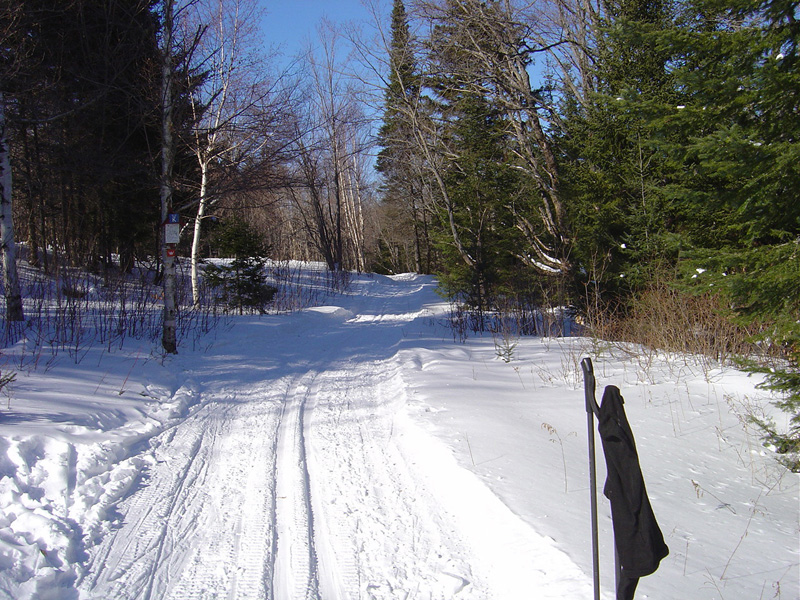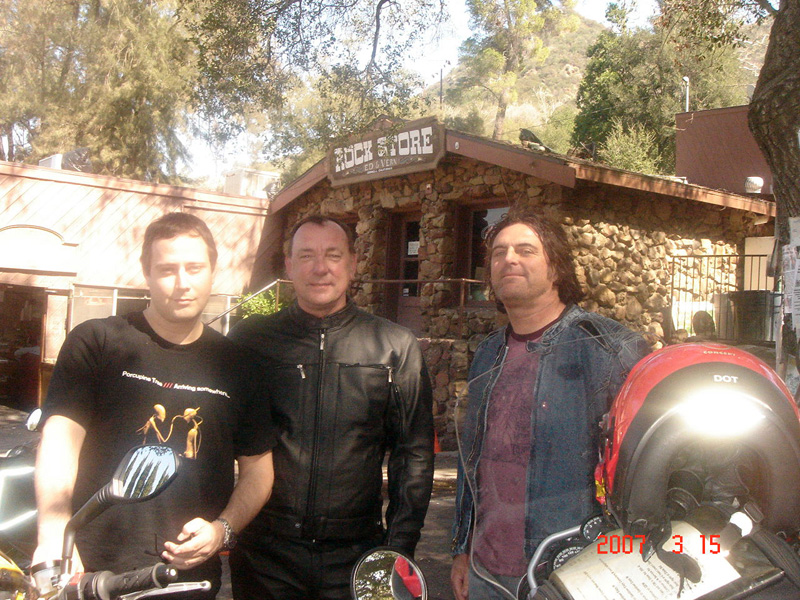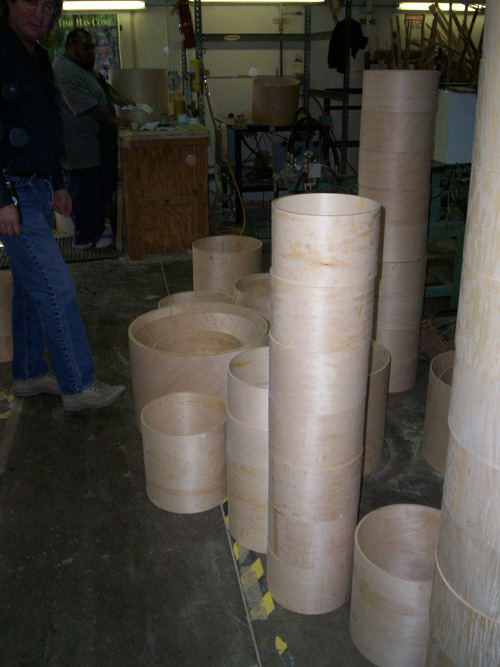Neil Peart's News, Weather and Sports
The Count Of Words
NeilPeart.net, March 2007
As I have been writing to my friends over the past few weeks, "Sorry I haven't been writing - I've been too busy writing."
The first big job I had to do was the essay I always write to accompany the release of a new Rush album. It might seem fairly easy to put together a few pages about a piece of work like that, but I find it to be the hardest kind of writing - except for lyrics, it occurs to me now. For similar reasons, too, because I'm trying to use the fewest words possible to convey the greatest amount of information. Lyrics are the most difficult, yet have the fewest words - maybe two hundred - and the next hardest are short prose pieces, a couple thousand words or so, because they carry a heavy load.
Somehow short pieces for other people's books, like the introduction to Kevin Anderson's story collection, Landscapes, or the afterword for a new edition of Lesley Choyce's The Republic of Nothing, weren't as difficult. Perhaps that's because they were about other people's work, and the "audience" is clearly limited to readers of those books. For the album-introduction essays, the intended audience ranges from industry people to journalists, and from casual readers to ardent fans. The story will be sent out with the new CD, at least on the label's Web site, and the band's, and will sometimes be quoted in the press and on radio and TV, then be printed (finally) in the tour book. That scattershot target affects the kind of story I try to present, and the way I try to present it.
Thinking of the essay I wrote for Vapor Trails, "Behind the Fire," the one for the Rush in Rio DVD, "Flying Blind in Rio," and even the introduction for the tourbook anthology, "Works on Paper," each of those short pieces took about two solid weeks of hard work. In that same amount of time, instead of a three- or four-page essay, I might turn out forty pages of a book, or even two or three songs.
For those most recent three Rush essays, I even called upon the expertise of my book editor, Paul McCarthy. Paul has an insightful sense of "the reader's experience," and helps me with the chronology, clarity, and completeness of the story he feels I am trying to tell. After I've worked at the first draft for several days, I send it to Paul, and he responds with reams of commentary and suggestions. I have described Paul's editorial method before as "critical enthusiasm" - first telling me how much he likes what I've done, then suggesting all the ways I could make it better. I nearly always see what Paul is aiming for (or aiming me for), and try to make those changes. I keep chipping away at the story, word by word and paragraph by paragraph, trying to make it all flow as well as I can.
Because of that method, Paul isn't the kind of editor who "edits," as in making things shorter. By the time I incorporate the details he suggests, and find ways to groom them into the story, it only gets longer. My first draft of the Snakes and Arrows piece was about 2,300 words, the same length as the Vapor Trails story, but by the time Paul and I were done, it had grown to 3,300. (To put that in perspective, this little story is already over 580 words.)
Well, no matter. I had no doubt the story's length was "right," and that was simply how long it had to be. Still, I was concerned about whether people would want to read all that, and also the number of pages it would take - all those trees!
But I needn't have worried. Whether or not people will actually read that whole story, hardly anybody actually prints things like that anymore - including our record company, apparently, who will only post it on a Web site so people can download it if they want. Not as nice as an elegant presentation on paper to accompany the CD, I don't think, but . . . I guess that's business. Especially in a struggling business like the record industry. (Whether or not they deserve to be struggling is an open question.)
Writing in such a concentrated form, I try to distill everything down to its essence, yet still include every drop of the story. I also follow the advice of Professor Strunk in The Elements of Style, always trying to decide "What does the reader need to know first?" Paul subscribes to that overview as well, and in pursuing it, I find myself facing many technical challenges - much as I do in composing a drum part.
However, that problem-solving can be a good thing, and sometimes helps with other work. For example, when I was in the middle of the first draft of Traveling Music, I had to pause to write the "Flying Blind in Rio" essay. It happened that some of the problems I faced in the essay, like the handling of time - present, immediate past, and distant past - helped when I faced the same problems in the book.
So that's all good. But - it takes time.
And, after all that painstaking labor, no one has ever complimented me on the actual writing in any of those little pieces. Friends praise my lyrics sometimes, or my books, but never seem to notice all of the work that goes into those essays. However, it seems that if I have managed to weave all of those threads together into a seamless story, then the actual writing is transparent - as it should be, of course. Like the quote from Ovid I have used in book reviews, "if the art is concealed, it succeeds."
When I did finally sign off on the Snakes and Arrows piece this week (it will appear over on the band site when the CD is released), I immediately started working on a story for Modern Drooler (oh, those drummer jokes!).
Editor Bill Miller and I discussed a "drummer's point-of-view" kind of story about the making of Snakes and Arrows, looking at each of the tracks in terms of composing and creating the drum parts, as well as the technical overview of hardware and recording. So I started working on that, and it's looking like that story will turn out to be about 5,000 words.
Thus . . . "I haven't been writing because I've been too busy writing."
(And just look at that - now we're at almost 1,100 words already!)
My friend Michael has created another kind of "Web presence" for me over on MySpace, and I wanted to explain about that. Michael was largely responsible for motivating me to launch this here "official" site (along with Greg Russell, who had registered the domain name long before we met, and long before he designed the site). Apart from being my security consultant and riding partner, Michael is a professional computer forensics investigator, and keeps an eye on internet issues for me. He told me there were many "impostors" masquerading as me on fake MySpace pages, and that made me bristle. I'm sure anyone would understand why - Michael showed me one note from an embarrassed lady who had been corresponding with someone she thought was me for weeks, and she felt humiliated and duped. I can only imagine what those liars might be saying to others while pretending to be me. Ick.
So, in an effort to combat that, Michael suggested we put up an "authentic" MySpace page, so at least we would have grounds to have the others taken down. Fair enough, and he did a nice job of it - though I confess I rarely go there myself. Michael keeps trying to show me the list of "friends," and make me read the comments, but I get too embarrassed. All that fuss about me? No way.
But don't take that as anything negative - not at all. Even if I don't read those messages personally, I believe they still spread "good energy," as we Californians say.
In any case, I just wanted to explain about that. So far, the only way I'm genuinely communicating with people, other than with lyrics, drums, and books, is through these long, long stories (over 1,380 words so far - see how they add up?).
Otherwise (and weather-wise), the jasmine started blooming here in Southern California just a few days ago. As I described at the beginning of Roadshow, that is one of the most intoxicating smells, especially at night. Already, in mid-March, birds are nesting, trees are leafing, gardens are blooming, and spring is definitely here (it takes a few years of living in California to discern the subtle shift of seasons, for they are discreet, but discrete). Even while spring springs here, my other home in Quebec is buried in snow.
During a recent visit up there (while working on that Snakes and Arrows essay and the details of the cover art, proofreading lyrics and credits, and listening to the final masters), I had a few perfect cross-country ski days - bright sun and powdery snow, -10° Centigrade, two parallel grooves in the snow to follow, and no one else around. Here's a photo I took one afternoon while taking a break for a chicken salad sandwich and some peanut butter cups.

That's my balaclava hanging on the ski pole to dry for a minute - the air might be cold, but even by late February the sun starts to get strong, and after an hour or two of skiing up and down those woodland trails, I am soaked with sweat.
That was only about two weeks ago now, and I can guarantee that no one around that neighborhood went for a glorious motorcycle ride yesterday, as I did - now that I'm back in California. Every few months for the past couple of years, Michael, Greg, and I have held occasional "Web site meetings" over a seafood lunch on the Pacific Coast Highway, followed by a motorcycle ride in the Santa Monica Mountains (it's business - a legitimate write-off). Michael on his 1200 GS, Greg on his new V-Strom, and me on my 1200 GS from the R30 tour, this time we were joined by Motorcyclist editor Brian Catterson and guitarist John Wesley from Porcupine Tree, on a pair of KTM test bikes.
During lunch, Brian told me that an article I had written for him a few months back - about my favorite motorcycle destinations on the R30 tour - will finally be appearing in their May issue, along with excerpts from Roadshow. Brian said he had also written a "sidebar" story about riding with Michael and me for the second time on that tour.
After lunch, Brian led the four of us in a symmetrical, staggered formation up through the tree-lined tunnel of Old Topanga Canyon Road, then onto Mulholland and north along several other winding little lanes, through canyons and along ridgetops. Brian set a perfect pace - sporting and technically engaging, but with plenty of reserve for sudden gravel or oncoming traffic around those blind corners. We wandered way up past Malibu into Ventura County, then meandered along a tiny road I hadn't discovered before - Sycamore Canyon. (Like motojournalists and their favorite roads, you're sometimes reluctant to share that information - not wanting to spoil it - but like most of those writers, I figure it's better to be generous.)
On that one-and-a-half-lane, squiggly little road, through live-oak trees and dry chaparral, with fewer and fewer scattered ranches, we climbed high above deep, fingered canyons and monumental rocky outcrops. Then suddenly the landscape fell away before us, and we looked out to the wide blue sweep of the Pacific Ocean. The turquoise shallows and breaking surf seemed so far below. (As Brian had warned us earlier, "It's a narrow, dirty little road, and if you fall down - you fall down.")
And that, it occurs to me, is the Sports Report for this issue. And the Weather, too.
The word for both of those - and indeed, for the News part of the Report (as in "Colbert") - is "ni-i-ice" (as in Borat).
Here's a photo of Michael, Brian, and me in front of the famous Rock Store on Mulholland Highway. (Wes took the picture, so he's not in it, and Greg had to go home early and take care of real business.) On weekends, hundreds of motorcyclists gather at the Rock Store, a panorama of bikes you sometimes see in motorcycle magazine photographs, but as you might expect, I prefer to cruise by on a weekday, like yesterday, even though the place was closed.
The road was open!

I notice that my tankbag, in the foreground, still displays the directions to get to the band's warehouse from when I did "The Mercer Report" TV show in Toronto last October. That is a clue that I haven't been taking any motorcycle trips for a while, other than errands around town. No adventures like that coming up in the immediate future, either, because in just a couple of weeks I will be heading for Toronto (not by motorcycle - it's still winter between here and there) to start rehearsing for the upcoming tour.
Then I'll get plenty of motorcycling . . .
Anyone who knows much about this reporter will understand that I am not entirely thrilled about embarking on another long concert tour - but I am looking forward to preparing for it.
I really do love rehearsing - getting in good drumming condition, playing the songs again and again until I'm strong and accurate, working out a new solo, meshing with Alex and Geddy as a band, and playing those songs until we're strong and accurate. All that is challenging and satisfying.
And it's exciting to see the whole production come together around us, and to hang around with "the guys at work." Likewise, the first few shows are challenging and satisfying (if they're good, at least), but after that . . . not so much.
I've written before that when I once tried to make a list of "things I like about touring," I only came up with two: "1/Lots of motorcycling," and "2/ I can eat anything I want." (Because I work so hard, and sweat so much.)
Not that I'm complaining, you understand. It's not my first time at the rodeo (I love that expression), and there are plenty of worse ways to earn a living - nearly all of them, in fact. My friend Kevin Anderson, a successful and prolific author, wrote recently, "My worst day as a writer is probably better than nearly everyone else's best day at whatever they do." Like Kevin, I remain grateful to be able to make my living doing something I love.
Though my favorite part of this job has always been the process we've just completed - getting together with my two pals and creative partners to write and record a bunch of new songs. Not that that's easy either, but the rewards are both more immediate, and more enduring. After struggling for hours with some lyrics, or a drum part, and hearing nothing but the flaws, there are few better feelings than coming in the next day to listen, and thinking, "hey - maybe it's not so bad after all."
In contrast, touring is the "other" part of the job for me. I know I keep "quoting previously quoted quotes," but I can't resist Mark Twain's definition of work, "Anything you'd rather not do." And once again I have to repeat a remark about touring that our manager, Ray, made to me a few years back, "Hey, how else could you go on a nice long motorcycle trip, and pick up a little gas money along the way?"
Well . . .
In any case, I will do my best onstage every night, and on two wheels every day.
Because that's what I do.
And that brings us to over 2,650 words. In case anybody else is keeping score.
My fingertips are getting as callused as my hands will be later this year, from drumming, and perhaps that's about enough for today.
Though I will take this opportunity to apologize in advance if it's a while before I post another one of these little newsletters. I'm about to get very, very busy. Until - oh - November.

In closing, here's a top secret spy photo of the new drumset DW is building for me to play on the upcoming tour. It incorporates several technical innovations developed by John Good since he designed the tobacco sunburst recording kit I used on Snakes and Arrows (formerly the "West Coast" kit, originally built for Matt Scannell's sessions early last summer). Many people have described those drums as the "best they've ever heard," but the new ones are going to be even better.
So far it's just a stack of bare shells, as you can see, but even they sound amazing when John strikes them in his special "timbre-matching" way.
As for the finish and hardware, that's going to be a surprise. I'll only say, "Black is the new gold," and "Red is the new black."
And that makes 2,893 words - and three pictures, each of which is famously worth a thousand words. So I think 5,893 words ought to be about enough.
As the television lawyers say (when they're trying to act all badass), "We're done here."